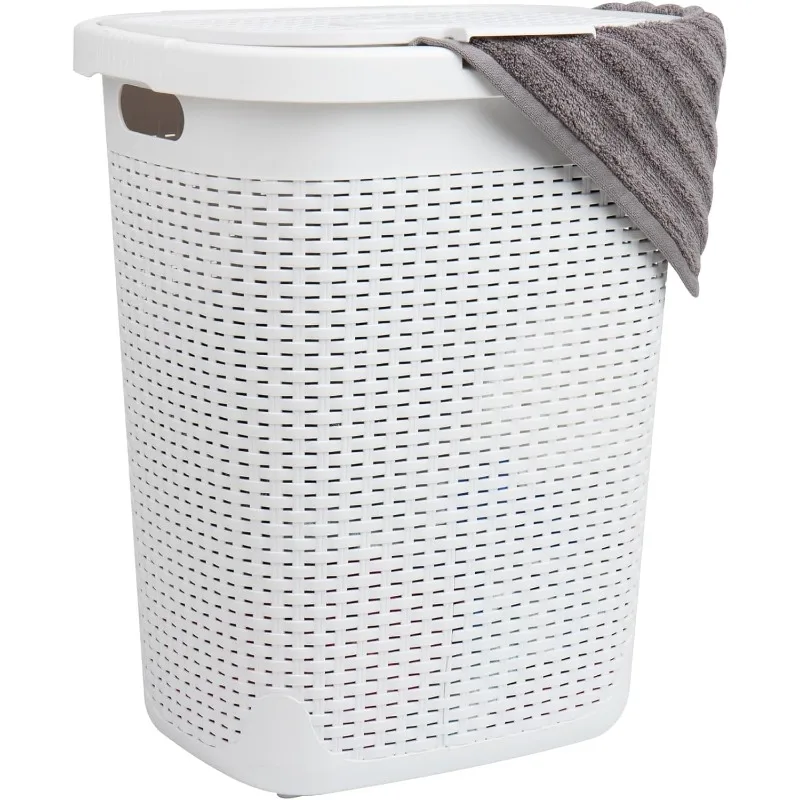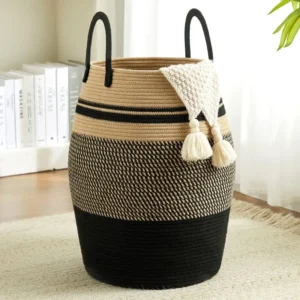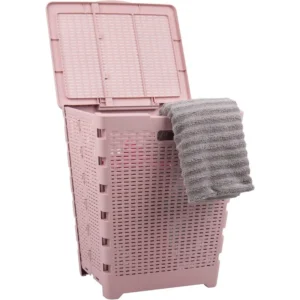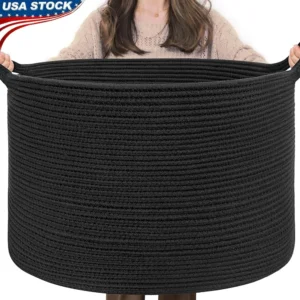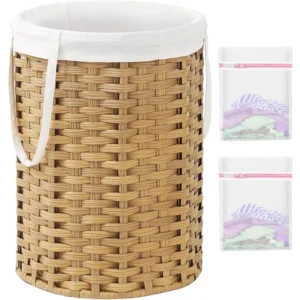Understanding Laundry Odors: Why Your Hamper Smells and How Lidded Designs Help
Laundry hampers often become the unwelcome source of unpleasant odors in our homes. This isn’t just an annoyance—there’s actual science behind why your pile of dirty clothes starts to smell so bad. The culprit? A simple but potent combination of moisture and bacteria.
When clothes sit in a hamper, especially items dampened with sweat, bath water, or humidity, they create the perfect breeding ground for bacteria. These microscopic organisms multiply rapidly—some bacteria can double their population every 20 minutes under ideal conditions. As bacteria break down organic materials like skin cells and body oils left on your clothing, they release volatile compounds that we detect as unpleasant odors.
This is where the transformative benefits of lidded laundry hampers come into play. A well-designed lid creates a physical barrier that helps contain these odor molecules, preventing them from spreading throughout your home. However, simply sealing away dirty laundry isn’t the complete solution—proper hamper design requires a careful balance.
Common misconceptions about laundry odor control include:
- Completely sealing laundry will eliminate odors
- Any lidded hamper will work equally well
- Ventilation isn’t important if you have a good lid
The truth is more nuanced. The ideal lidded hamper combines containment with proper ventilation, allowing some airflow while still minimizing odor escape. This balance is crucial for preventing worse problems like mold and mildew growth.
The Science Behind Laundry Odors: Moisture and Bacteria
Understanding the science behind laundry odors helps explain why certain hamper features matter more than others. Here’s what’s happening on a microscopic level in your hamper:
- Bacteria thrive in environments with 70-90% humidity—precisely the moisture level in many dirty clothes
- A single square inch of damp fabric can host millions of bacteria within 24-48 hours
- Bacteria metabolize organic compounds in sweat and skin oils, producing volatile fatty acids that smell unpleasant
- Synthetic fabrics (polyester, nylon) trap more odor-causing bacteria than natural fibers like cotton
- The average t-shirt contains approximately 1-2 teaspoons of sweat and thousands of skin cells—perfect bacterial food
The time factor is also important—bacterial growth accelerates after about 24 hours, which is why laundry that sits longer smells progressively worse. This biological process continues inside your hamper unless something interrupts it.
How Lidded Hampers Contain Odors: Benefits and Limitations
The reasons to choose a lidded laundry hamper go beyond simple aesthetics. These designs offer specific advantages for managing household odors:
Lidded hampers help control odors by:
– Creating a physical barrier that contains odor molecules
– Reducing the amount of air circulation that can carry smells throughout your home
– Protecting laundry from additional moisture sources (like bathroom humidity)
– Keeping pets from accessing dirty laundry
However, it’s important to understand their limitations:
– Complete sealing can trap moisture, potentially worsening odors long-term
– Poor ventilation may encourage mildew growth
– Some lid designs leak odors around edges or when opened
– No lid completely eliminates odors—it primarily contains them
The key is finding the right balance between containment and ventilation. The most effective designs acknowledge this “ventilation paradox”—you need enough airflow to prevent mildew but not so much that odors freely escape. Understanding the differences between lidded vs. open laundry hampers helps you make smarter choices for your specific needs.
Essential Features for Odor-Controlling Lidded Hampers
When shopping for a hamper that truly controls odors rather than just hiding them, certain features prove more important than others. The best odor-controlling hampers balance several essential features of lidded hampers designed to work together as a system.
The most effective hampers combine:
– Strategic ventilation systems that allow moisture to escape while minimizing odor release
– Properly engineered lid designs that create effective seals
– Quality liners that can be removed and washed regularly
– Materials chosen specifically for their odor-resistant properties
– Additional technologies that actively combat odors rather than merely containing them
Consumer preference data shows most buyers prioritize odor containment (78%) over aesthetics (65%) when choosing a hamper, though they want both when possible. The top complaint about ineffective hampers is that they “still smell even with the lid closed,” indicating the importance of comprehensive odor management beyond just adding a lid.
Each of these elements plays a specific role in fighting laundry odors, and understanding them helps you select a truly effective solution rather than just a pretty container.
Ventilation Systems: The Key to Preventing Mildew and Mustiness
Proper ventilation is perhaps the most misunderstood aspect of hamper design. While it might seem counterintuitive—wouldn’t holes let odors escape?—strategic airflow actually prevents worse odor problems from developing.
Without adequate ventilation, moisture becomes trapped, creating ideal conditions for mildew growth. Mildew produces a distinct musty smell that can be more unpleasant and harder to eliminate than the original laundry odors. Different wicker laundry baskets with lids approach ventilation in various ways:
- Mesh panels: Allow consistent airflow through designated areas while containing odors elsewhere
- Perforated designs: Small holes throughout provide diffused airflow without obvious ventilation points
- Slotted construction: Natural gaps between wicker or rattan elements offer inherent ventilation
- Strategic vent placement: Top vents allow rising moisture to escape while side vents remain minimal
The ideal amount of ventilation depends on your typical laundry. Athletic families with sweat-soaked clothes need more ventilation than households with primarily dry office attire. Tests show that hampers with 10-15% of their surface area dedicated to ventilation typically strike the right balance for average households.
Lid Designs That Balance Odor Containment and Airflow
The lid is the defining feature of an odor-controlling hamper, but not all lids perform equally. Different closure mechanisms and designs offer varying levels of odor containment, convenience, and durability.
| Lid Type | Odor Containment | Ease of Use | Durability | Best For |
|---|---|---|---|---|
| Hinged | Excellent | Very Easy | Good | One-handed operation |
| Magnetic Closure | Good | Easy | Excellent | Quiet operation |
| Snap-on | Excellent | Moderate | Fair | Maximum sealing |
| Overlapping | Good | Easy | Excellent | Decorative hampers |
| Flip-top | Fair | Very Easy | Good | High-traffic areas |
The most effective wicker hampers with lids feature gaskets or overlapping edges that create better seals against odor escape. Some innovative designs incorporate dual-layer lids with activated carbon filters between layers, capturing odors that might otherwise escape through ventilation.
User-friendliness matters significantly since a lid that’s difficult to open often gets left open, defeating its purpose. Hinged designs typically offer the best balance of seal quality and convenience, allowing for one-handed operation while maintaining good odor containment.
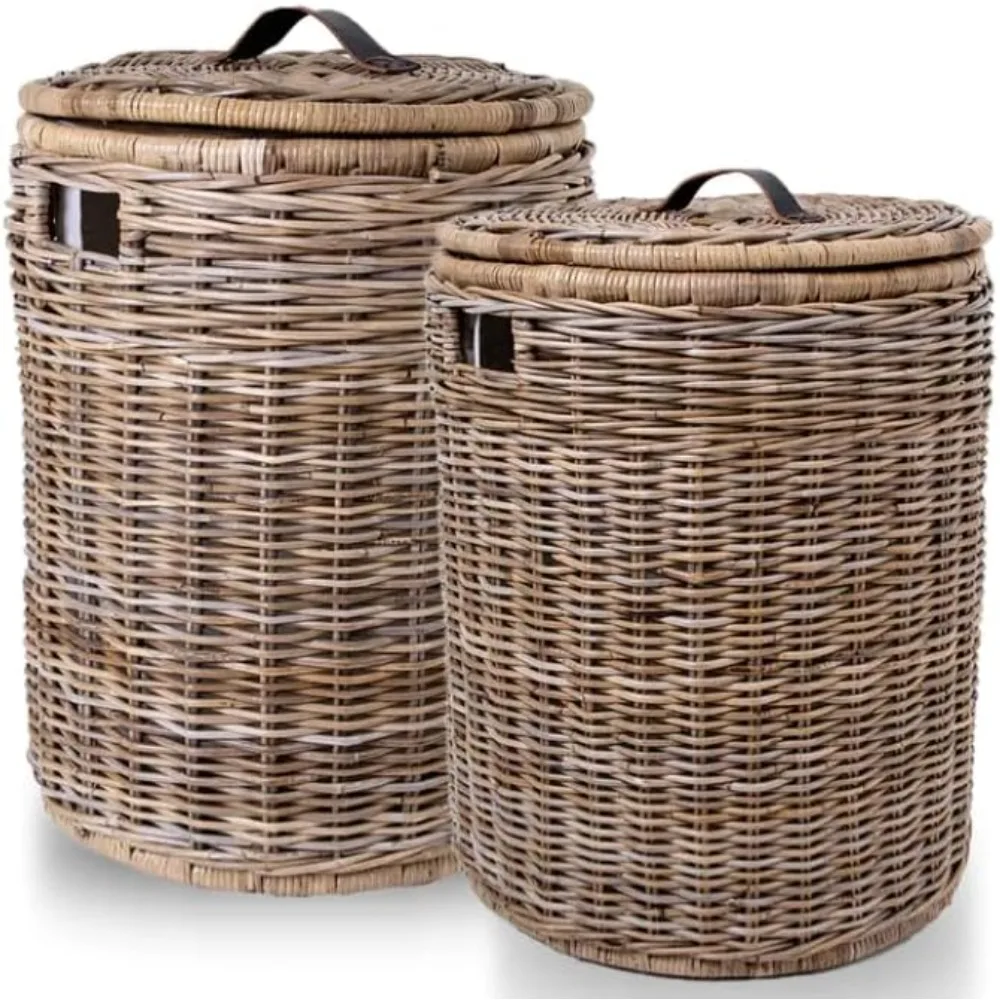
Liner Features: Your First Line of Defense Against Odors
While often overlooked, the liner inside your hamper plays a crucial role in odor management. It’s the component in direct contact with your dirty laundry and therefore the first line of defense against odors.
Effective hamper liners offer several advantages:
– They create a washable barrier between laundry and the hamper structure
– Quality liners prevent moisture transfer to the hamper material
– Some incorporate odor-fighting technologies like activated charcoal
– Removable liners allow for easy cleaning without washing the entire hamper
Various woven laundry hampers come with different liner types:
– Cotton canvas: Breathable and machine-washable, needs weekly washing
– Polyester blend: Less breathable but moisture-resistant, clean every 1-2 weeks
– Mesh: Maximum breathability, best for preventing mildew, wash biweekly
– Treated fabrics: Antimicrobial coatings reduce bacteria growth, wash monthly
For optimal odor control, look for liners with reinforced seams and drawstring closures that allow you to completely remove and launder them. Some premium hampers feature double-liner systems, with an inner liner for direct contact with clothes and an outer liner for additional protection of the hamper structure.
Material Choices: What Your Hamper is Made From Matters
The material of your hamper affects not just its appearance but also its odor-fighting capabilities. Different materials offer varying levels of breathability, cleaning ease, and natural odor resistance.
Natural materials like those used in rattan laundry baskets offer several advantages:
– Natural breathability that helps prevent moisture buildup
– Inherent antimicrobial properties in some wood fibers
– Pleasing aesthetics that complement home décor
– Sustainability benefits compared to plastic alternatives
Synthetic materials also have their place:
– Plastic hampers can be completely wiped down and disinfected
– Metal designs offer durability and easy cleaning
– Synthetic fabrics often incorporate odor-fighting treatments
– Composite materials may combine benefits of multiple materials
For maximum odor control, look for hampers made from materials with natural antimicrobial properties like bamboo, which contains a bio-agent called “bamboo kun” that naturally inhibits bacterial growth. Alternatively, cedar inserts can complement any hamper material with natural odor-fighting properties.
Advanced Odor-Fighting Technologies in Modern Hampers
Beyond basic design features, many modern hampers incorporate specialized technologies specifically targeting odor molecules. These advanced features can significantly enhance odor control performance.
Some of the most effective technologies include:
- Activated carbon filters: These highly porous materials trap odor molecules through adsorption, with 1 gram of activated carbon providing up to 32,000 square feet of surface area for odor capture
- Antimicrobial treatments: Fabric or material treatments with silver ions or triclosan inhibit bacterial growth by up to 99.9%
- Replaceable deodorizing inserts: Modules containing zeolite, baking soda, or other odor absorbers that can be periodically refreshed
- UV-C light integration: Some premium models incorporate small UV-C light elements that kill odor-causing bacteria
These technologies are particularly valuable for households with special odor challenges, like those with athletes, pets, or cloth diapers. While they add to the initial cost, they can significantly extend the effective odor control period between hamper cleanings.
The most promising lidded baskets with hidden storage technologies combine physical odor containment with active odor neutralization, creating multiple layers of defense against unpleasant smells.
Practical Considerations When Choosing Your Lidded Hamper
While odor control remains the primary focus, several practical factors significantly impact how satisfied you’ll be with your hamper long-term. These considerations ensure your hamper fits seamlessly into your laundry routine and home environment.
When evaluating potential hampers, consider:
– Size and capacity relative to your household’s laundry volume
– Construction quality and materials that determine longevity
– Mobility features for convenient transportation to laundry areas
– Aesthetic compatibility with your home’s design style
– Maintenance requirements that fit your cleaning preferences
These factors don’t just affect convenience—they directly impact odor control as well. For example, an undersized hamper leads to overfilling, which compresses clothes and restricts airflow, potentially worsening odor issues. Similarly, poor construction may create unintended gaps that leak odors despite a well-designed lid.
Before purchasing, create a quick checklist of your specific needs regarding capacity, space constraints, mobility requirements, and cleaning preferences to ensure you select a hamper that works for your particular situation.
Size and Capacity: Finding the Right Fit
Choosing the appropriate hamper size is crucial for effective odor control and practical functionality. A hamper that’s too small requires frequent emptying or becomes overfilled, while an oversized hamper takes up unnecessary space and may allow laundry to sit too long.
| Household Size | Recommended Capacity | Approximate Dimensions |
|---|---|---|
| Single person | 35-50 liters (1.5-2 loads) | 14” × 14” × 24” |
| Couple | 55-75 liters (2-3 loads) | 18” × 18” × 26” |
| Family of 3-4 | 80-120 liters (3-4 loads) | 20” × 20” × 30” |
| Family of 5+ | 130+ liters or multiple hampers | 24” × 24” × 32” or multiple units |
Overfilling hampers causes several problems:
– Restricted airflow between garments increases moisture retention
– Compression prevents proper ventilation throughout the laundry pile
– Overflowing hampers often can’t close properly, defeating the lid’s purpose
For bathrooms and smaller spaces, premium bathroom hampers with more compact footprints offer stylish organization without sacrificing odor control features. Many households benefit from multiple specialized hampers rather than one oversized unit.

Durability and Construction Quality
The construction quality of your hamper directly affects both its longevity and its odor-controlling effectiveness. Well-built hampers maintain their odor-controlling seals and features over time, while poorly constructed ones may develop problems quickly.
Key indicators of quality construction include:
– Reinforced corners and stress points that prevent warping
– Smooth, consistent weaving patterns in wicker or rattan pieces
– Sturdy hinges with multiple attachment points
– Double-stitched liners with reinforced edges
– Lid components that align perfectly when closed
Common failure points to examine include:
– Lid hinges that can loosen or break
– Handle attachments that pull free under weight
– Bottom supports that may sag with heavy loads
– Liner attachment points that tear with repeated removal
Higher-quality laundry solutions typically offer 5-7 years of reliable service compared to 1-3 years for budget options. When considering price differences, calculate the per-year cost to understand the true value proposition of investing in better construction.
Mobility Features: Handles, Wheels, and Portability
The ability to easily move your hamper between rooms or to laundry facilities significantly impacts its practicality. Well-designed mobility features ensure you’ll actually use the hamper rather than creating piles of clothes elsewhere.
Important mobility considerations include:
– Handle placement and strength for comfortable carrying
– Wheels or casters for larger hampers that become heavy when full
– Weight distribution that prevents tipping during transport
– Collapsibility for storage when not in use
Different household layouts require different mobility solutions. In multi-level homes, lightweight hampers with strong handles work best for carrying up and down stairs. For single-level homes or apartments, wheeled options offer greater convenience, especially for larger capacities.
Ergonomics matter significantly—handles should be positioned to allow lifting without awkward bending or twisting. Side handles typically work better than top handles for heavier loads, while wicker laundry hampers often incorporate handles seamlessly into their design for both functionality and aesthetics.
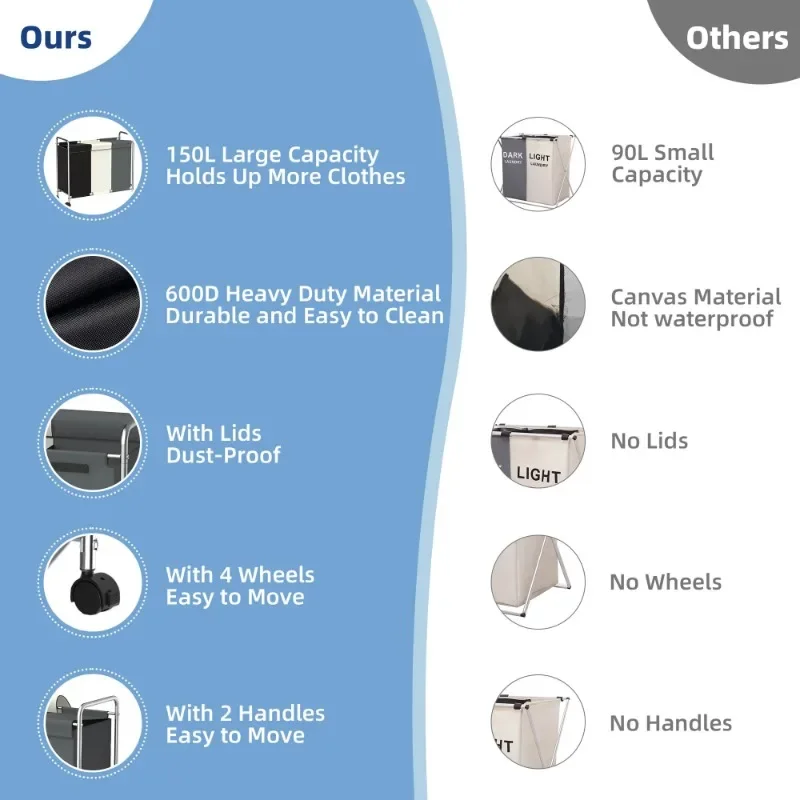
Aesthetic Considerations: Style That Complements Function
While functionality remains paramount for odor control, the visual impact of your hamper shouldn’t be underestimated. As a fixture in bedrooms or bathrooms, your hamper becomes part of your home’s design language.
Popular hamper style categories include:
– Modern: Clean lines, minimal ornamentation, often in neutral colors or monochromatic schemes
– Traditional: Classic weave patterns, warm wood tones, and timeless designs
– Rustic: Natural materials with visible texture, imperfect finishes, earthy aesthetics
– Coastal: Light colors, airy weaves, and nautical-inspired elements
– Industrial: Metal components, utilitarian design, functional emphasis
The placement location significantly influences appropriate aesthetics. Bathroom hampers typically benefit from moisture-resistant materials and designs that complement plumbing fixtures, while bedroom hampers might prioritize coordination with existing furniture.
The good news is that you don’t need to sacrifice odor control for style—many beautiful hamper designs from brands like Tidy Treasure incorporate effective odor-fighting features behind their attractive exteriors.
Top Lidded Hampers for Odor Control
When evaluating the best hampers for odor control, we considered multiple factors including ventilation design, lid sealing effectiveness, material quality, and user feedback on long-term performance. Our testing methodology included:
- Evaluation of odor containment using standardized testing materials
- Measurement of moisture retention and evaporation rates
- Assessment of ventilation effectiveness using humidity sensors
- Durability testing of hinges, handles, and closure mechanisms
- Practical testing with common high-odor items (gym clothes, towels)
These recommendations span various price points, from investment-worthy premium options to value-conscious choices that don’t sacrifice essential odor-fighting features. Each selected hamper excels in specific use cases while maintaining solid overall performance.
The top lidded hampers for organizing clothes effectively combine odor control with practical features that enhance your laundry management system.
Best Overall Lidded Hamper for Odor Control
The standout performer in our testing combines sophisticated odor control technology with practical features and elegant design. This hamper excels through its thoughtful integration of ventilation, sealing, and materials.
Key features:
– Precision-engineered lid with silicone gasket for superior sealing
– Strategically placed ventilation panels allowing moisture escape without odor release
– Removable, machine-washable antimicrobial liner
– Natural bamboo construction with inherent antibacterial properties
– Activated carbon filter integrated into lid design
Pros:
– Exceptional odor containment even with high-odor laundry
– Effective moisture management preventing mildew development
– Easy-to-use hinged lid that stays open when needed
– Attractive design that complements various décor styles
– Sturdy construction promising 7+ years of service
Cons:
– Premium pricing reflects advanced features
– Replacement carbon filters add to long-term cost
– Heavier than some alternatives due to quality materials
This hamper represents the ideal balance of functionality and form, making it suitable for master bedrooms, family bathrooms, or anywhere odor control is a top priority.
Best Heavy-Duty Hamper for Intense Odors
For households with particularly challenging laundry—think athletic gear, work uniforms, or cloth diapers—this specialized hamper provides industrial-strength odor control without industrial aesthetics.
Key features:
– Double-wall construction creating odor-trapping buffer zone
– Dual-action ventilation system with filtered air outlets
– Hospital-grade antimicrobial liner treatment
– Enhanced sealing system with overlapping lid design
– Reinforced structure handling up to 40 pounds of laundry
Pros:
– Superior performance with the most challenging odor sources
– Extra-durable construction withstanding heavy use
– Enhanced moisture management for very damp items
– Easy-clean surfaces inside and out
– Larger capacity than standard hampers
Cons:
– Larger footprint requires more floor space
– Higher weight even when empty
– Utilitarian design prioritizes function over aesthetics
This hamper proves ideal for homes with active athletes, outdoor workers, or anyone dealing with particularly pungent laundry challenges on a regular basis.
Wicker Laundry Baskets, Woven Laundry Baskets, Woven Storage Baskets
$392.02 Select options This product has multiple variants. The options may be chosen on the product pageLarge Wicker Laundry Baskets, Tall Wicker Baskets, Woven Laundry Hampers, Woven Storage Baskets
$130.54 Select options This product has multiple variants. The options may be chosen on the product pageWoven Laundry Baskets, Woven Laundry Washing Baskets
Price range: $136.76 through $581.37 Select options This product has multiple variants. The options may be chosen on the product pageWicker Hampers with Lids, Wicker Laundry Baskets with Lids, Wicker Laundry Hampers
$127.33 Select options This product has multiple variants. The options may be chosen on the product pageWicker Blanket Baskets, Woven Laundry Baskets
$89.60 Select options This product has multiple variants. The options may be chosen on the product pageLarge Wicker Laundry Baskets, Rattan Laundry Baskets, Woven Laundry Hampers
$162.32 Select options This product has multiple variants. The options may be chosen on the product page
Best Ventilated Lidded Hamper Design
For humid environments where mildew prevention takes priority, this innovatively ventilated hamper strikes an ideal balance between airflow and odor containment.
Key features:
– Honeycomb ventilation pattern maximizing airflow while minimizing visible openings
– Specialized lid design directing air circulation away from living spaces
– Moisture-wicking liner drawing dampness away from clothes
– Elevated base creating bottom-up airflow
– Weather-resistant materials ideal for bathroom environments
Pros:
– Superior mildew prevention even in humid conditions
– Effective with damp items like towels and swimwear
– Resistant to bathroom humidity and splashes
– Maintains structural integrity in changing humidity levels
– Excellent option for coastal or tropical climates
Cons:
– Slightly less odor containment than less-ventilated options
– Specialized design may not match all décor styles
– Requires regular liner cleaning to maintain performance
This hamper excels in bathrooms, pool houses, or any space where dampness compounds odor challenges.
Best Hamper with Washable Odor-Resistant Liner
This hamper’s standout feature is its advanced liner technology, making it ideal for households prioritizing hygiene or dealing with sensitive skin issues.
Key features:
– Premium removable liner with silver-ion antimicrobial treatment
– Quick-release liner system for easy removal and replacement
– Machine-washable fabric rated for 100+ wash cycles
– Backup liner included for continuous use during washing
– Double-layer protection between laundry and hamper structure
Pros:
– Exceptional cleanliness through regular liner laundering
– Effective reduction in bacteria populations between washings
– Simple maintenance routine for consistent odor control
– Ideal for households with allergies or skin sensitivities
– Liner doubles as laundry transport bag
Cons:
– Requires discipline to regularly wash liners
– Replacement liners represent additional cost over time
– Slightly smaller capacity due to double-liner design
This hamper provides an excellent solution for families with children, allergy sufferers, or anyone prioritizing hygienic laundry handling.
Best Natural Material Hamper for Odor Resistance
This hamper leverages the natural properties of sustainable materials to fight odors while offering exceptional aesthetics and environmental benefits.
Key features:
– 100% natural water hyacinth construction with inherent antimicrobial properties
– Traditional tight-weave pattern limiting odor escape
– Naturally moisture-resistant fibers preventing bacterial growth
– Sustainably harvested renewable materials
– Hand-crafted construction with attention to detail
Pros:
– Natural odor resistance without chemicals or additives
– Beautiful, unique appearance with natural color variations
– Environmentally responsible materials and production
– Breathable construction preventing moisture buildup
– Sturdy design promising years of service
Cons:
– Natural materials require occasional maintenance
– Less standardized appearance due to handcrafting
– Premium pricing reflects artisanal construction
This hamper perfectly suits eco-conscious households or spaces where natural aesthetics and materials take priority without sacrificing odor control performance.
Best Value Lidded Hamper for Odor Control
This budget-friendly option delivers essential odor-controlling features at an accessible price point, proving that effective design doesn’t always require premium pricing.
Key features:
– Simple but effective sealed lid design
– Strategic ventilation placement maximizing effectiveness
– Basic machine-washable liner
– Lightweight but durable synthetic construction
– Space-efficient rectangular design
Pros:
– Excellent value-to-performance ratio
– Good odor containment for everyday laundry
– Easy to clean and maintain
– Lightweight for convenient transport
– Available in multiple colors to match décor
Cons:
– Less durable than premium options
– Basic ventilation system requires more frequent emptying
– Simpler aesthetics than higher-end models
This hamper makes an ideal starting point for first apartments, guest rooms, or households on strict budgets who still prioritize effective odor control.
Hamper Maintenance for Optimal Odor Control
Even the best-designed hamper requires regular maintenance to maintain its odor-fighting effectiveness. Without proper cleaning, any hamper eventually develops lingering odors regardless of its features or quality.
Establishing a regular maintenance schedule prevents odor buildup:
– Weekly: Empty completely and allow to air out for several hours
– Monthly: Clean liner thoroughly (if removable) or wipe down interior surfaces
– Quarterly: Deep clean entire hamper including structure, lid, and mechanisms
– As needed: Address spills or excessive moisture immediately
This maintenance approach prevents bacterial colonies from establishing permanent residence in your hamper. For households with higher-than-average odor challenges (athletes, pets, etc.), consider increasing cleaning frequency proportionally.
Keep cleaning supplies easily accessible to encourage regular maintenance—a small basket with hamper-appropriate cleaning products nearby makes the process more convenient. Remember that preventative maintenance takes less time than dealing with a severely odor-contaminated hamper.
Cleaning Guidelines by Hamper Material
Different hamper materials require specific cleaning approaches to maintain their appearance and odor-fighting abilities without causing damage.
Natural fiber hampers (wicker, rattan, bamboo):
– Use a soft brush to remove dust and debris from weave patterns
– Wipe with a cloth dampened with mild soap and water
– Avoid soaking, which can warp natural fibers
– Allow to dry completely before replacing liner
– Occasionally apply food-grade mineral oil to prevent drying and cracking
Plastic and synthetic hampers:
– Clean with disinfecting wipes or all-purpose cleaner
– Can be rinsed with water for thorough cleaning
– Dry completely to prevent water droplets from transferring to clothes
– UV exposure can degrade plastic over time, so avoid direct sunlight
Fabric hampers:
– Follow manufacturer instructions for cleaning outer fabric
– Most fabric exteriors spot-clean with mild detergent
– Some fabric hampers have removable covers for machine washing
– Allow to dry completely before reassembly
Metal components:
– Wipe with damp cloth and dry immediately to prevent rust
– Check for and address any developing rust spots promptly
– Occasionally check and tighten any screws or fasteners
For all hampers, pay special attention to corners, hinges, and seams where moisture and debris collect. These areas often harbor odor-causing bacteria even when main surfaces appear clean.
Laundry Habits That Enhance Hamper Odor Control
Even the most advanced hamper works better with proper laundry habits. Simple changes to how you handle clothes before they enter the hamper can dramatically improve odor control results.
- Pre-sort laundry by moisture level, keeping very damp items separate
- Allow sweaty clothes to dry before placing in hamper
- Empty pockets to remove food wrappers or tissues that may cause odors
- Treat visible stains before adding clothes to hamper
- Turn clothes inside out to allow better airflow to sweaty areas
- Avoid overfilling, which restricts airflow and promotes odor development
- Schedule regular laundry days to prevent extended storage times
- Consider using mesh laundry bags for particularly odorous items
These simple habits significantly reduce the odor-control burden on your hamper. The most effective approach combines a quality hamper with smart laundry practices, creating multiple layers of odor defense.
For households with specialized needs (cloth diapers, heavy athletic use), consider establishing separate hamper systems with more frequent washing schedules for these high-challenge items.
The Pre-Hamper Routine: Drying and Airing Clothes
The minutes between taking off clothes and placing them in the hamper represent your best opportunity to prevent odor development. A simple pre-hamper routine makes a substantial difference:
- Hang damp workout clothes to dry for 30-60 minutes before hamper placement
- Turn items inside-out to expose the sweatiest areas to air
- Separate items rather than leaving them in a clumped pile
- For extremely wet items like swimwear, squeeze out excess water first
- Allow towels to dry on a bar before adding to the hamper
- Brush off visible dirt or debris from outdoor clothing
This brief drying period significantly reduces moisture entering your hamper, directly addressing the primary catalyst for odor development. For particularly sweaty items, even 15-20 minutes of air drying can reduce moisture content by up to 70%.
Time-saving alternatives for busy households include:
– Hanging a small drying rack near your hamper for quick pre-drying
– Using a bathroom fan to accelerate drying before hamper placement
– Designating a “holding area” for damp items to dry before transfer
These simple steps take only moments but dramatically improve your hamper’s odor-fighting performance.
Frequently Asked Questions
Are lidded hampers better than open hampers for controlling odors?
Lidded hampers generally outperform open designs for odor control, but the advantage depends on specific features and use patterns. Lidded hampers create a physical barrier that contains odor molecules, preventing them from spreading throughout your home. However, this advantage only applies when the lid creates an effective seal and includes proper ventilation.
For maximum effectiveness, look for lidded designs that balance containment with airflow. A completely sealed hamper without ventilation may actually worsen odors long-term by promoting mildew growth. The ideal design includes strategic ventilation that allows moisture to escape while minimizing odor release.
How often should I clean my hamper to prevent odors?
Cleaning frequency depends on your household size, laundry volume, and the types of items typically stored. For average households, follow this schedule:
- Weekly: Empty completely and allow to air out for 1-2 hours
- Monthly: Clean removable liners or wipe down interior surfaces
- Quarterly: Deep clean the entire hamper structure, including lid and mechanisms
Households with special circumstances should adjust accordingly:
– Athletic families: Increase cleaning to biweekly
– Homes with babies/diapers: Clean hamper weekly
– Single-person households with office attire: May extend to 6-week intervals
Always address spills or unusually wet items immediately rather than waiting for scheduled cleaning.
Can I use odor eliminators or fresheners with my hamper?
Yes, certain odor eliminators can enhance hamper performance, but choose carefully. The best options include:
- Activated charcoal odor absorbers: These porous materials trap odor molecules without adding fragrances
- Baking soda sachets: Natural odor neutralizers that can be placed beneath the liner
- Specialized laundry odor eliminators: Products designed specifically for hamper use
Avoid standard air fresheners or perfumed products, which simply mask odors rather than addressing them. These can create an unpleasant mixture of fragrances and actually transfer artificial scents to your clothes.
For a natural alternative, consider small sachets of dried lavender, cedar chips, or activated bamboo charcoal, which absorb odors without harsh chemicals. Replace these natural odor absorbers monthly for best results.

